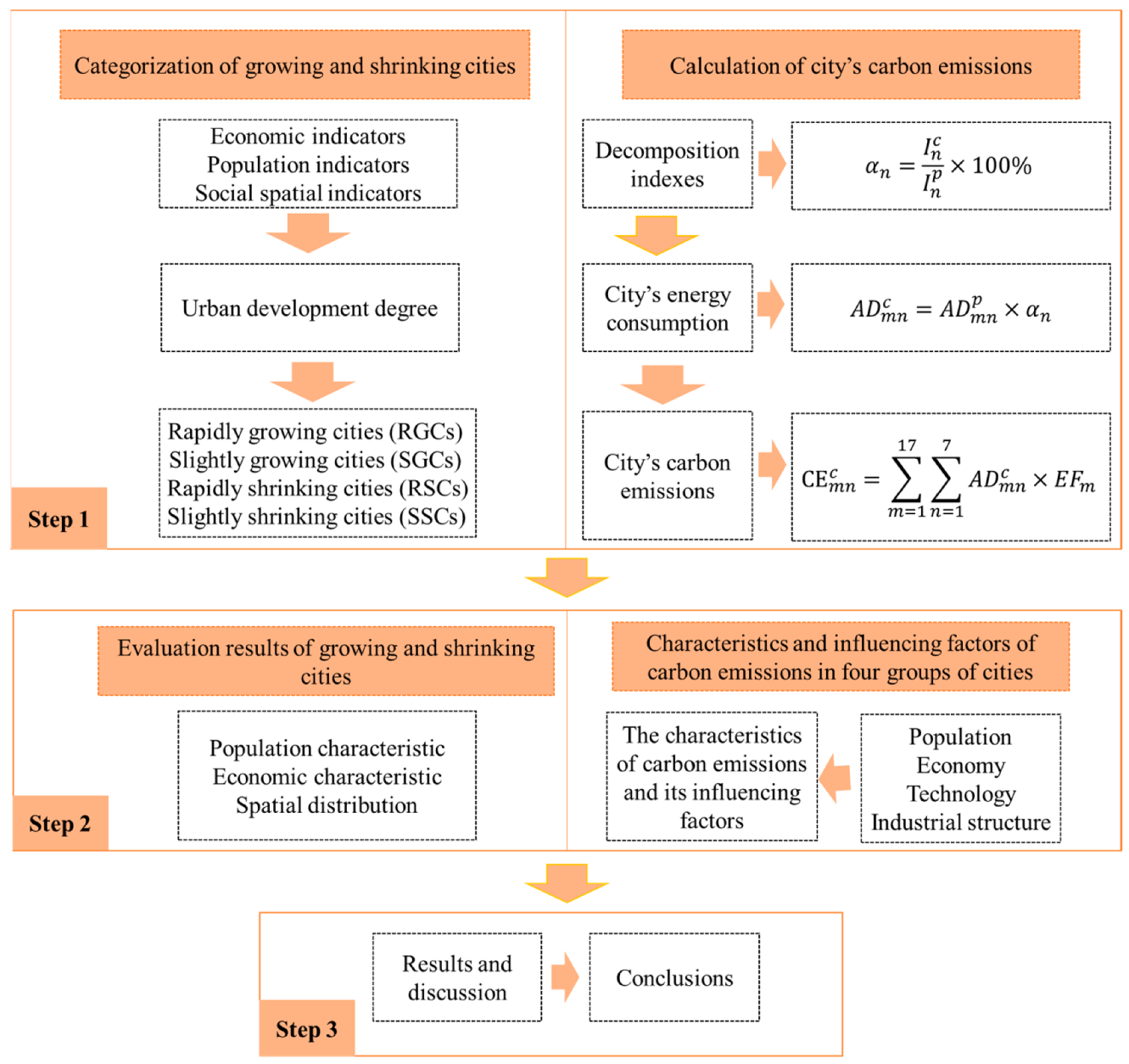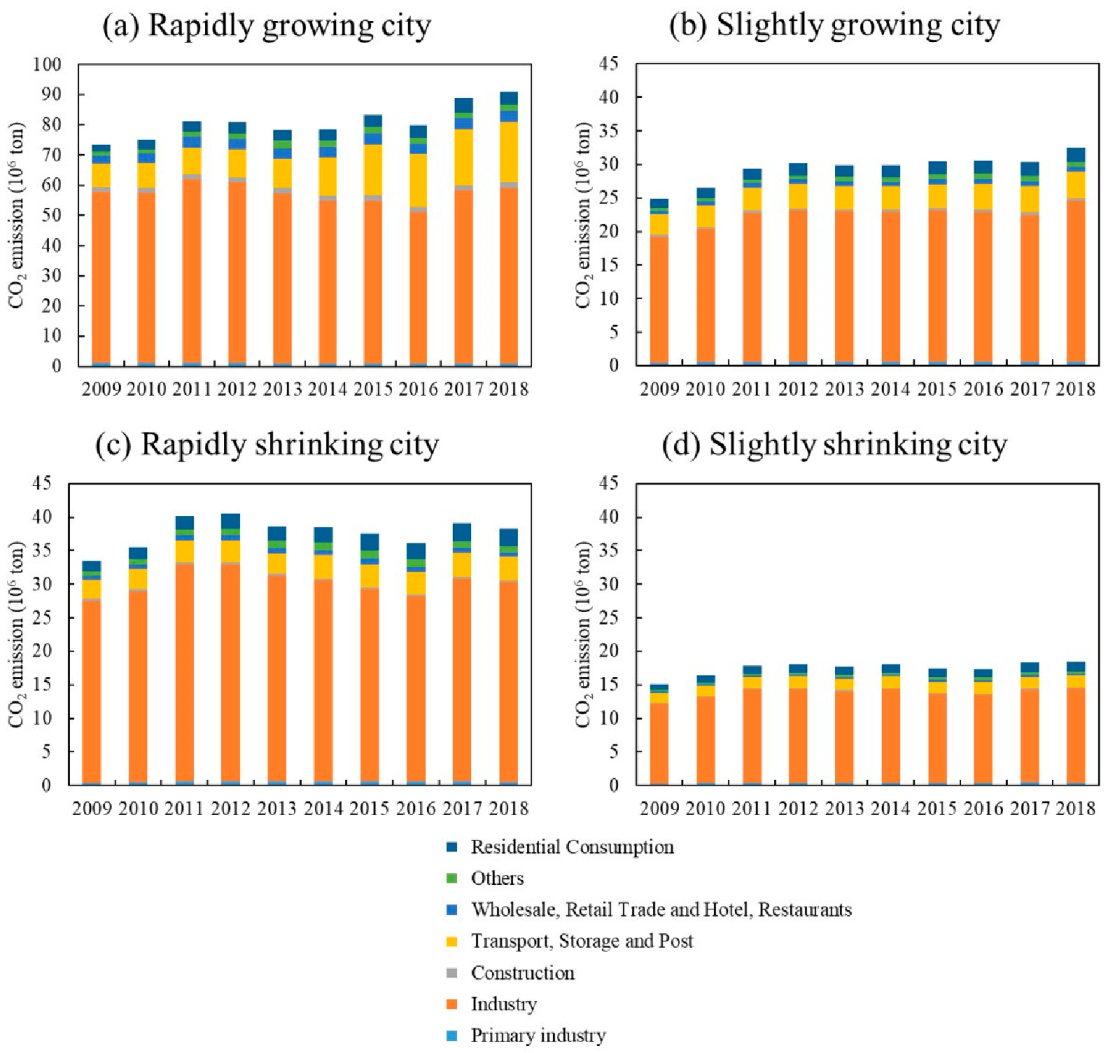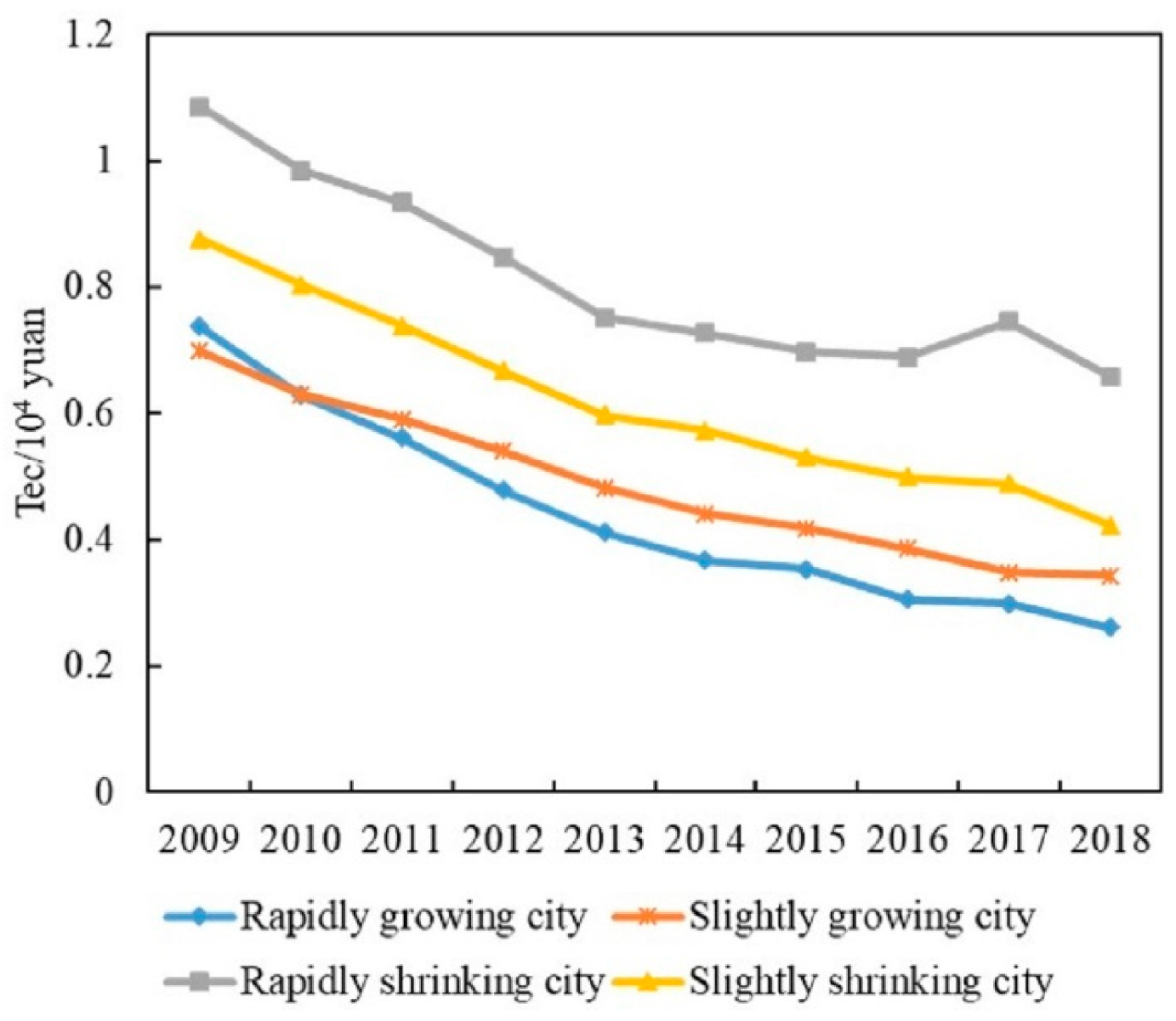Carbon-Emission Characteristics and Influencing Factors in Growing and Shrinking Cities: Evidence from 280 Chinese Cities
Abstract
:1. Introduction
2. Literature Review
3. Method
3.1. Research Framework
3.2. Categorization of Shrinking and Growing Cities
3.3. CO2 Emission Accounting
3.4. STIRPAT Model
3.5. Research Objects and Data Sources
4. Results and Discussion
4.1. Results for Growing and Shrinking Cities
4.1.1. Characteristics of Growing Cities
4.1.2. Characteristics of Shrinking Cities
4.2. Emission Characteristics of Growing and Shrinking Cities
4.2.1. Rapidly Growing Cities (RGCs)
4.2.2. Slightly Growing Cities (SGCs)
4.2.3. Rapidly Shrinking Cities (RSCs)
4.2.4. Slightly Shrinking Cities (SSCs)
4.3. Regression Results
4.4. Discussion
5. Conclusions and Policy Implications
Author Contributions
Funding
Institutional Review Board Statement
Informed Consent Statement
Data Availability Statement
Conflicts of Interest
References
- Yuan, J.H.; Xu, Y.; Hu, Z.; Zhao, C.H.; Xiong, M.P.; Guo, J.S. Peak energy consumption and CO2 emissions in China. Energy Policy 2014, 68, 508–523. [Google Scholar] [CrossRef]
- den Elzen, M.; Fekete, H.; Hohne, N.; Admiraal, A.; Forsell, N.; Hof, A.F.; Olivier, J.G.J.; Roelfsema, M.; van Soest, H. Greenhouse gas emissions from current and enhanced policies of China until 2030: Can emissions peak before 2030? Energy Policy 2016, 89, 224–236. [Google Scholar] [CrossRef] [Green Version]
- Dhakal, S. Urban energy use and carbon emissions from cities in China and policy implications. Energy Policy 2009, 37, 4208–4219. [Google Scholar] [CrossRef]
- Dhakal, S. GHG emissions from urbanization and opportunities for urban carbon mitigation. Curr. Opin. Environ. Sustain. 2010, 2, 277–283. [Google Scholar] [CrossRef]
- Shan, Y.L.; Guan, D.B.; Hubacek, K.; Zheng, B.; Davis, S.J.; Jia, L.C.; Liu, J.H.; Liu, Z.; Fromer, N.; Mi, Z.F.; et al. City-level climate change mitigation in China. Sci. Adv. 2018, 4, eaaq0390. [Google Scholar] [CrossRef] [Green Version]
- Long, Y.; Wu, K. Shrinking cities in a rapidly urbanizing China. Environ. Plan. A 2016, 48, 220–222. [Google Scholar] [CrossRef] [Green Version]
- He, S.Y.; Lee, J.; Zhou, T.; Wu, D. Shrinking cities and resource-based economy: The economic restructuring in China’s mining cities. Cities 2017, 60, 75–83. [Google Scholar] [CrossRef]
- Zhou, C.S.; Wang, S.J. Examining the determinants and the spatial nexus of city-level CO2 emissions in China: A dynamic spatial panel analysis of China’s cities. J. Clean. Prod. 2018, 171, 917–926. [Google Scholar] [CrossRef]
- Zhu, Z.Q.; Liu, Y.; Tian, X.; Wang, Y.F.; Zhang, Y. CO2 emissions from the industrialization and urbanization processes in the manufacturing center Tianjin in China. J. Clean. Prod. 2017, 168, 867–875. [Google Scholar] [CrossRef]
- Hung, C.C.W.; Hsu, S.C.; Cheng, K.L. Quantifying city-scale carbon emissions of the construction sector based on multi-regional input-output analysis. Resour. Conserv. Recycl. 2019, 149, 75–85. [Google Scholar] [CrossRef]
- Wang, H.K.; Lu, X.; Deng, Y.; Sun, Y.G.; Nielsens, C.P.; Li, Y.F.; Zhu, G.; Bu, M.L.; Bi, J.; McElroy, M.B. China’s CO2 peak before 2030 implied from characteristics and growth of cities. Nat. Sustain. 2019, 2, 748–754. [Google Scholar] [CrossRef]
- Huang, Y.; Liao, C.P.; Zhang, J.J.; Guo, H.X.; Zhou, N.; Zhao, D.Q. Exploring potential pathways towards urban greenhouse gas peaks: A case study of Guangzhou, China. Appl. Energ. 2019, 251, 113369. [Google Scholar] [CrossRef]
- Lin, J.Y.; Kang, J.F.; Khanna, N.; Shi, L.Y.; Zhao, X.F.; Liao, J.F. Scenario analysis of urban GHG peak and mitigation co-benefits: A case study of Xiamen City, China. J. Clean. Prod. 2018, 171, 972–983. [Google Scholar] [CrossRef]
- Zhang, Y.Q.; Liu, C.G.; Chen, L.; Wang, X.F.; Song, X.Q.; Li, K. Energy-related CO2 emission peaking target and pathways for China’s city: A case study of Baoding City. J. Clean. Prod. 2019, 226, 471–481. [Google Scholar] [CrossRef]
- Sun, L.; Liu, W.J.; Li, Z.L.; Cai, B.F.; Fujii, M.; Luo, X.; Chen, W.; Geng, Y.; Fujita, T.; Le, Y.P. Spatial and structural characteristics of CO2 emissions in East Asian megacities and its indication for low-carbon city development. Appl. Energ. 2021, 284, 116400. [Google Scholar] [CrossRef]
- Cai, B.F.; Guo, H.X.; Cao, L.B.; Guan, D.B.; Bai, H.T. Local strategies for China’s carbon mitigation: An investigation of Chinese city-level CO2 emissions. J. Clean. Prod. 2018, 178, 890–902. [Google Scholar] [CrossRef] [Green Version]
- Meng, Z.S.; Wang, H.; Wang, B.N. Empirical Analysis of Carbon Emission Accounting and Influencing Factors of Energy Consumption in China. Int. J. Environ. Res. Public Health 2018, 15, 2467. [Google Scholar] [CrossRef] [Green Version]
- Ou, J.P.; Liu, X.P.; Wang, S.J.; Xie, R.; Li, X. Investigating the differentiated impacts of socioeconomic factors and urban forms on CO2 emissions: Empirical evidence from Chinese cities of different developmental levels. J. Clean. Prod. 2019, 226, 601–614. [Google Scholar] [CrossRef]
- Dong, K.Y.; Hochman, G.; Zhang, Y.Q.; Sun, R.J.; Li, H.; Liao, H. CO2 emissions, economic and population growth, and renewable energy: Empirical evidence across regions. Energ. Econ. 2018, 75, 180–192. [Google Scholar] [CrossRef]
- Fujii, H.; Iwata, K.; Chapman, A.; Kagawa, S.; Managi, S. An analysis of urban environmental Kuznets curve of CO2 emissions: Empirical analysis of 276 global metropolitan areas. Appl. Energ. 2018, 228, 1561–1568. [Google Scholar] [CrossRef] [Green Version]
- Wang, S.J.; Wang, J.Y.; Li, S.J.; Fang, C.L.; Feng, K.S. Socioeconomic driving forces and scenario simulation of CO2 emissions for a fast-developing region in China. J. Clean. Prod. 2019, 216, 217–229. [Google Scholar] [CrossRef]
- Li, L.; Lei, Y.L.; Wu, S.M.; He, C.Y.; Chen, J.B.; Yan, D. Impacts of city size change and industrial structure change on CO2 emissions in Chinese cities. J. Clean. Prod. 2018, 195, 831–838. [Google Scholar] [CrossRef]
- Boluk, G.; Mert, M. The renewable energy, growth and environmental Kuznets curve in Turkey: An ARDL approach. Renew. Sustain. Energy Rev. 2015, 52, 587–595. [Google Scholar] [CrossRef]
- Xu, G.Y.; Schwarz, P.; Yang, H.L. Adjusting energy consumption structure to achieve China’s CO2 emissions peak. Renew. Sustain. Energy Rev. 2020, 122, 109737. [Google Scholar] [CrossRef]
- Turok, I.; Mykhnenko, V. The trajectories of European cities, 1960–2005. Cities 2007, 24, 165–182. [Google Scholar] [CrossRef]
- Blanco, H.; Alberti, M.; Olshansky, R.; Chang, S.; Wheeler, S.M.; Randolph, J.; London, J.B.; Hollander, J.B.; Pallagst, K.M.; Schwarz, T.; et al. Shaken, shrinking, hot, impoverished and informal: Emerging research agendas in planning. Prog. Plan. 2009, 72, 195–250. [Google Scholar] [CrossRef]
- Schetke, S.; Haase, D. Multi-criteria assessment of socio-environmental aspects in shrinking cities. Experiences from eastern Germany. Environ. Impact Asses. 2008, 28, 483–503. [Google Scholar] [CrossRef]
- Martinez-Fernandez, C.; Weyman, T.; Fol, S.; Audirac, I.; Cunningham-Sabot, E.; Wiechmann, T.; Yahagi, H. Shrinking cities in Australia, Japan, Europe and the USA: From a global process to local policy responses. Prog. Plan. 2016, 105, 1–48. [Google Scholar] [CrossRef]
- Wiechmann, T.; Pallagst, K.M. Urban shrinkage in Germany and the USA: A Comparison of Transformation Patterns and Local Strategies. Int. J. Urban Reg. Res. 2012, 36, 261–280. [Google Scholar] [CrossRef]
- Xiao, H.J.; Duan, Z.Y.; Zhou, Y.; Zhang, N.; Shan, Y.L.; Lin, X.Y.; Liu, G.S. CO2 emission patterns in shrinking and growing cities: A case study of Northeast China and the Yangtze River Delta. Appl. Energ. 2019, 251, 113384. [Google Scholar] [CrossRef]
- Liu, X.J.; Wang, M.S.; Qiang, W.; Wu, K.; Wang, X.M. Urban form, shrinking cities, and residential carbon emissions: Evidence from Chinese city-regions. Appl. Energ. 2020, 261, 114409. [Google Scholar] [CrossRef]
- Martinez-Fernandez, C.; Audirac, I.; Fol, S.; Cunningham-Sabot, E. Shrinking Cities: Urban Challenges of Globalization. Int. J. Urban Reg. Res. 2012, 36, 213–225. [Google Scholar] [CrossRef]
- Yang, Z.; Dunford, M. City shrinkage in China: Scalar processes of urban and hukou population losses. Reg. Sustain. 2018, 52, 1111–1121. [Google Scholar] [CrossRef]
- Dong, B.Y.; Ye, Y.; You, S.X.; Zheng, Q.M.; Huang, L.Y.; Zhu, C.M.; Tong, C.; Li, S.N.; Li, Y.J.; Wang, K. Identifying and Classifying Shrinking Cities Using Long-Term Continuous Night-Time Light Time Series. Remote Sens. 2021, 13, 3142. [Google Scholar] [CrossRef]
- Zhou, Y.; Li, C.G.; Zheng, W.S.; Rong, Y.F.; Liu, W. Identification of urban shrinkage using NPP-VIIRS nighttime light data at the county level in China. Cities 2021, 118, 103373. [Google Scholar] [CrossRef]
- Yang, Y.; Wu, J.G.; Wang, Y.; Huang, Q.X.; He, C.Y. Quantifying spatiotemporal patterns of shrinking cities in urbanizing China: A novel approach based on time-series nighttime light data. Cities 2021, 118, 103346. [Google Scholar] [CrossRef]
- Lin, X.B.; Yang, C.W.; Zhang, X.C.; Cao, H. The measurement and influenceing factors analysis of urban shrinkage in China: Based on the perspective of demographic and economic changes. Hum. Geogr. 2017, 32, 82–89. (In Chinese) [Google Scholar]
- Zhang, S.; Wang, C.X.; Wang, J.; Yao, S.M.; Zhang, F.; Yin, G.W.; Xu, X.Y. A comprehensive measure of urban shrinkage in China and its spatial and temporal differences. Popul. Resour. Environ. 2020, 30, 72–82. (In Chinese) [Google Scholar]
- Shan, Y.L.; Guan, D.B.; Liu, J.H.; Mi, Z.F.; Liu, Z.; Liu, J.R.; Schroeder, H.; Cai, B.F.; Chen, Y.; Shao, S.; et al. Methodology and applications of city level CO2 emission accounts in China. J. Clean. Prod. 2017, 161, 1215–1225. [Google Scholar] [CrossRef] [Green Version]
- Shan, Y.L.; Guan, D.B.; Zheng, H.R.; Ou, J.M.; Li, Y.; Meng, J.; Mi, Z.F.; Liu, Z.; Zhang, Q. Data Descriptor: China CO2 emission accounts 1997–2015. Sci. Data 2018, 5, 170201. [Google Scholar] [CrossRef] [Green Version]
- Wang, S.J.; Liu, X.P. China’s city-level energy-related CO2 emissions: Spatiotemporal patterns and driving forces. Appl. Energ. 2017, 200, 204–214. [Google Scholar] [CrossRef]
- Qiang, W.; Lin, Z.W.; Zhu, P.Y.; Wu, K.; Lee, H.F. Shrinking cities, urban expansion, and air pollution in China: A spatial econometric analysis. J. Clean. Prod. 2021, 324, 129308. [Google Scholar] [CrossRef]
- Zheng, J.L.; Mi, Z.F.; Coffman, D.; Milcheva, S.; Shan, Y.L.; Guan, D.B.; Wang, S.Y. Regional development and carbon emissions in China. Energ. Econc. 2019, 81, 25–36. [Google Scholar] [CrossRef]







| Dimensions | Indicators | Unit |
|---|---|---|
| Population | Natural population growth rate | ‰ |
| Total population | 104 Person | |
| Population density | Person/km2 | |
| Economic | Per capita GDP | Yuan |
| Per capita fiscal revenue | Person/yuan | |
| GDP growth rate | % | |
| Social and Land use | Total retail sales of consumer goods | 104 yuan |
| Per capita fiscal expenditure | Person/yuan | |
| Built-up area | Km2 |
| City Groups | F-Test | Hausman Test | ||
|---|---|---|---|---|
| F-Value | Prob | Shi-Sq. Statistic | Prob | |
| RGCs | F = 1.07 | 0.3960 | 5.29 | 0.2587 |
| SGCs | F = 54.78 | 0.0000 | 193.76 | 0.0000 |
| RSCs | F = 14.74 | 0.0000 | 109.76 | 0.0000 |
| SSCs | F = 13.77 | 0.0000 | 300.80 | 0.0000 |
| Explanatory Variables | RGCs | SGCs | RSCs | SSCs |
|---|---|---|---|---|
| lnA | 0.351 | 0.743 *** | 0.68 *** | 0.74 *** |
| lnP | 0.449 | 0.943 *** | 0.722 *** | 0.605 *** |
| lnT | −0.424 | −0.709 *** | −0.518 *** | −0.547 *** |
| lnQ | 1.337 * | 0.042 | −0.111 *** | −0.097 *** |
| C | −6.7864 | −12.129 | −7.824 | −12.55 |
| R-squared | 0.2025 | 0.8912 | 0.9286 | 0.9486 |
| F | 1.91 | 972.17 | 146.13 | 655.53 |
| Number of obs | 90 | 1260 | 330 | 1120 |
| Year | RGCs | SGCs | RSCs | SSCs | ||||||||
|---|---|---|---|---|---|---|---|---|---|---|---|---|
| lnCO2′ | lnCO2 | Error (%) | lnCO2′ | lnCO2 | Error (%) | lnCO2′ | lnCO2 | Error (%) | lnCO2′ | lnCO2 | Error (%) | |
| 2009 | 8.51 | 8.86 | 4.01 | 7.46 | 7.43 | 0.41 | 8.07 | 7.78 | 3.72 | 6.99 | 7.00 | 0.03 |
| 2010 | 8.56 | 8.89 | 3.64 | 7.54 | 7.52 | 0.29 | 8.15 | 7.86 | 3.67 | 7.10 | 7.09 | 0.02 |
| 2011 | 8.60 | 8.96 | 4.00 | 7.62 | 7.62 | 0.01 | 8.25 | 7.99 | 3.21 | 7.19 | 7.19 | 0.06 |
| 2012 | 8.62 | 8.96 | 3.88 | 7.64 | 7.65 | 0.11 | 8.26 | 8.00 | 3.27 | 7.23 | 7.22 | 0.05 |
| 2013 | 8.68 | 8.94 | 2.90 | 7.65 | 7.66 | 0.04 | 8.24 | 7.96 | 3.59 | 7.19 | 7.21 | 0.33 |
| 2014 | 8.60 | 9.26 | 7.11 | 7.66 | 7.66 | 0.07 | 8.24 | 7.93 | 3.83 | 7.23 | 7.21 | 0.22 |
| 2015 | 8.61 | 9.00 | 4.26 | 7.67 | 7.68 | 0.13 | 8.20 | 7.89 | 3.97 | 7.21 | 7.20 | 0.21 |
| 2016 | 8.61 | 8.95 | 3.88 | 7.67 | 7.67 | 0.03 | 8.19 | 7.84 | 4.45 | 7.21 | 7.18 | 0.41 |
| 2017 | 8.68 | 9.06 | 4.20 | 7.67 | 7.67 | 0.01 | 8.21 | 7.88 | 4.14 | 7.24 | 7.22 | 0.20 |
| 2018 | 8.66 | 9.10 | 4.77 | 7.69 | 7.71 | 0.31 | 8.14 | 7.90 | 3.06 | 7.16 | 7.22 | 0.82 |
Publisher’s Note: MDPI stays neutral with regard to jurisdictional claims in published maps and institutional affiliations. |
© 2022 by the authors. Licensee MDPI, Basel, Switzerland. This article is an open access article distributed under the terms and conditions of the Creative Commons Attribution (CC BY) license (https://creativecommons.org/licenses/by/4.0/).
Share and Cite
Tong, X.; Guo, S.; Duan, H.; Duan, Z.; Gao, C.; Chen, W. Carbon-Emission Characteristics and Influencing Factors in Growing and Shrinking Cities: Evidence from 280 Chinese Cities. Int. J. Environ. Res. Public Health 2022, 19, 2120. https://doi.org/10.3390/ijerph19042120
Tong X, Guo S, Duan H, Duan Z, Gao C, Chen W. Carbon-Emission Characteristics and Influencing Factors in Growing and Shrinking Cities: Evidence from 280 Chinese Cities. International Journal of Environmental Research and Public Health. 2022; 19(4):2120. https://doi.org/10.3390/ijerph19042120
Chicago/Turabian StyleTong, Xinhua, Shurui Guo, Haiyan Duan, Zhiyuan Duan, Chang Gao, and Wu Chen. 2022. "Carbon-Emission Characteristics and Influencing Factors in Growing and Shrinking Cities: Evidence from 280 Chinese Cities" International Journal of Environmental Research and Public Health 19, no. 4: 2120. https://doi.org/10.3390/ijerph19042120





